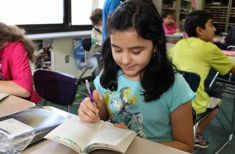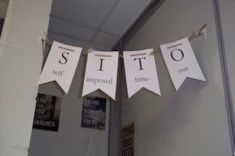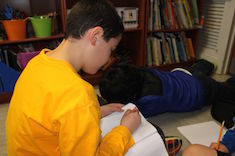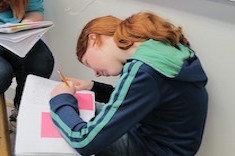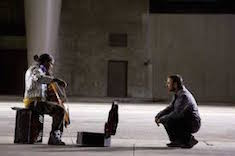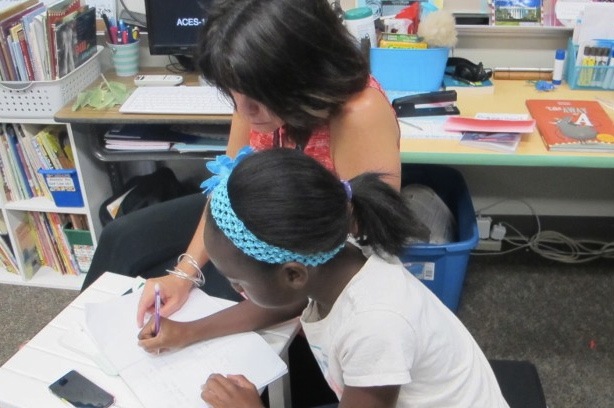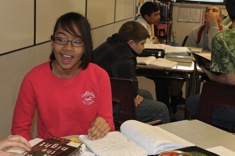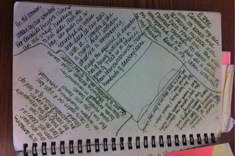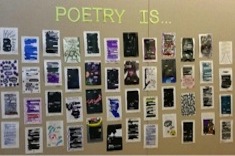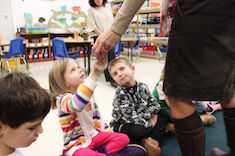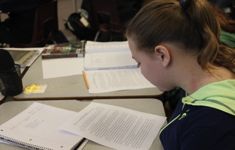8th
Latest Content
A Formula for Great Book Talks
Christy Rush-Levine explains her formula for successful book talks in middle school that grab students' attention. We've also included a sample book talk.
Getting Teens Out of Reading Ruts: The Sampler
Carly Ullmer describes the activity she’s developed for getting her middle school readers out of reading ruts by sampling different authors and genres.
Deep Reading of Picture Books in Middle School
Christy Rush-Levine shows the power of using picture books with young adolescents to model close reading and deepen comprehension of sophisticated texts.
SITO: Self-Imposed Time-Out
Christy Rush-Levine takes an oddly shaped unused nook in her classroom and turns it into a charming space where students can choose to take a quiet break with a “Self-Imposed Time-Out” (SITO).
Building Stamina in Middle School Writers
Carly Ullmer finds herself wasting a lot of time because of interruptions during student conferences, so she makes building stamina in her middle school students a priority.
Invitations for Narrative Writing
Kim Campbell suggests activities and prompts to energize narrative writing with teens.
Visual Reading for Writing
Carly Ulmer uses visual literacy to build writing skills with her seventh graders through two powerful minilessons.
Literary Analysis and Authenticity in Middle School
Christy Rush-Levine finds the best way to help her middle school students learn to read closely for literary analysis is through student writing. They begin with analyzing student exemplars from the Common Core, and then move to shared texts as they hone their skills.
Embracing Standards in Creative Ways
Christy Rush-Levine makes links between standards, video clips, and close reading.
Data That Matters
What information is gathered by a teacher sitting in a rocking chair quietly watching her students? Christy Rush-Levine discovers it is plenty.
Just Reading?
Christy Rush-Levine challenges the notion that there is anything easy or natural about getting young teens to select and read books independently in classrooms.
Speed Dating Books
Carly Ullmer presents a fun activity for introducing teens to new books and each other as readers, capitalizing on their interests.
The Beginnings of a Middle School Literacy Community
What do you do on day one? Christy Rush-Levine describes the routines in her middle school classroom.
Feed Forward
Carly Ullmer learns a powerful lesson about teaching her middle school students to respond to peer writing.
Student-Created Text Sets
Jillian Heise’s middle school students design text sets late in the school year. It’s a great activity for discovering how they have grown as readers, as well as a gift to next year’s class.
Closing Out the Year with “Where I’m From”
Jillian Heise shares a marvelous poetry writing activity for students who are transitioning from elementary to middle school, or middle to high school.
Student Learning Targets
Christy Rush-Levine finds she has to rethink learning targets for her middle school students if she wants students to pursue complex and lifelong reading goals.
Book Blurbs in the Middle School Classroom
Jillian Heise uses the quirky genre of book blurbs in her middle school classroom to model summaries and glean information about students’ comprehension, reading interests, and writing skills.
Giving Students a Notebook Tour
Melanie Meehan finds a notebooks tour is a terrific minilesson for helping students expand the ways they use notebooks.
Blackout Poems and Paint-Chip Haiku: Two Fun Ways into Poetry with Adolescents
Jillian Heise uses the lowly paint-chip board to inspire poetry in her middle school students.
Teaching Search Skill Basics to Students
Bill Bass has advice for teaching web-based search skills to students.
10 Ways to Publish Student Work
Erin Ocon compiles a list of the ways she publishes writing of her teen students.
How to Get a Book to Catch Fire
If your goal is to get teens more excited about independent reading, Gretchen Schroeder has suggestions to help.
Don’t Judge a Book by Its Cover: Teaching Book Choice Strategies to Middle Schoolers
Katie Doherty helps students make choices for independent reading.
Philanthropy and Literacy in Eighth Grade
Beth Honeycutt and Rita Schaeffer introduce a reading and writing activity to their eighth-grade students designed to help them understand philanthropy, using a video to enhance the lesson.
Supporting Introverts in Literacy Workshops
Kim Campbell has suggestions for ways teachers can help introverts have more say in literacy workshops.
Inform, Inspire, Instruct: Essays as Mentor Texts in High School
Kim Campbell shares her favorite nonfiction short texts to use with adolescents.
The Weight of Stories
Some of our students lead such hard lives. Christy Rush-Levine explores how teachers can keep from being dragged into the undertow of the most difficult situations children face.
My Middle Schoolers Still Can’t Spell!: Focusing on Individual Students
Gretchen Taylor concludes her two-part series on spelling instruction in middle school. In this installment, Gretchen visits a colleague in the primary grades to get advice and practical insight.
The Power of Reading Habits
Gretchen Taylor’s overscheduled middle school students have almost no time for reading outside the classroom. She finds that some reflective inquiry helps them build reading habits at home.
Browse Content By
Type
Category
- Assessment Tools
- Big Fresh Archives
- Booklists
- Choice Numeracy
- Classroom Design
- Common Core
- Community Building
- Conferring
- Content Literacy
- Digital Literacy
- English Language Learners
- Equity
- Family Relations
- Free Samples
- Guiding Groups
- Leadership
- Literacy Coaches
- Mentor Texts
- Minilessons
- New Teacher Mentors
- Podcasts
- Poetry
- Quote Collections
- Reading Strategies
- Self Care
- Struggling and Striving Learners
- Talking and Listening
- Teacher Study Groups
- Teaching Reading
- Teaching Writing
- Word Study and Vocabulary
Author
- Melissa Quimby
- Nawal Qarooni
- Gwen Blumberg
- Julie Cox
- The Lead Learners
- Hannah Tills
- Josie Stewart
- Ruth Metcalfe
- Mallory Messenger
- Becca Burk
- Jodie Bailey
- Vivian Chen
- Mary Brower
- Tiffany Abbott Fuller
- Stephanie Affinito
- Ruth Ayres
- Leigh Anne Eck
- Heather Fisher
- Shari Frost
- Julie Johnson
- Suzy Kaback
- Gigi McAllister
- Shirl McPhillips
- Melanie Meehan
- Cathy Mere
- Debbie Miller
- Tara Barnett and Kate Mills
- Tammy Mulligan
- Dana Murphy
- Bitsy Parks
- David Pittman
- Brenda Power
- Heather Rader
- Matt Renwick
- Mandy Robek
- Christy Rush-Levine
- Gretchen Schroeder
- Jen Schwanke
- Brian Sepe
- Katherine Sokolowski
- Stella Villalba
- Jennifer Vincent
Grade Level
Choice Literacy Membership
Articles
Get full access to all Choice Literacy article content
Videos
Get full access to all Choice Literacy video content
Courses
Access Choice Literacy course curriculum and training


